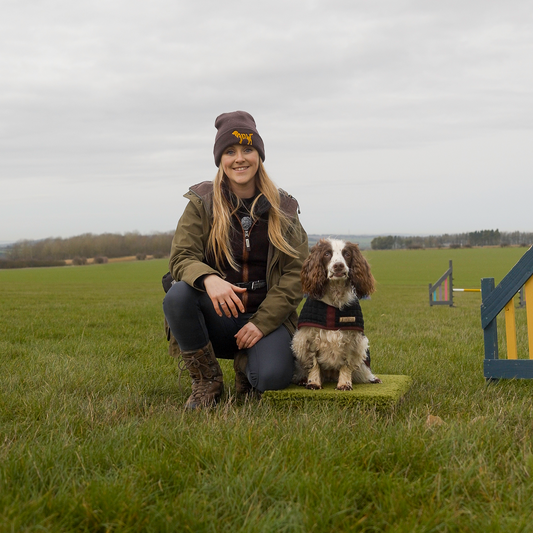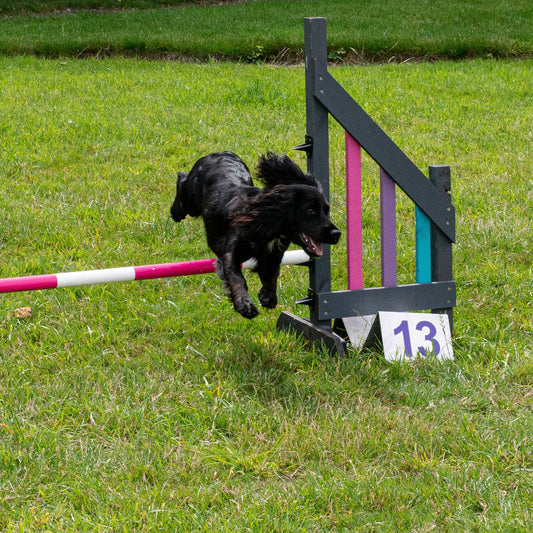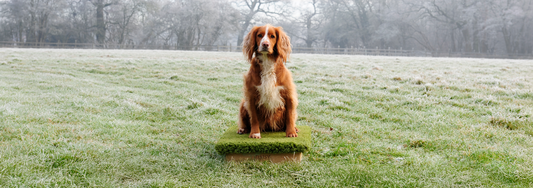
What is scent work?
Scent work is teaching an indicator behaviour such as nose targeting, in the presence of a cue which is odour.
The benefits of scent work:
Smell is an important sense to dogs. The part of a dogs’ brain that processes responsible scents detected by their noses is approximately 40 times larger in dogs than in humans, relative to total brain size.
Therefore engaging this part of the dogs’ brain in scent work training is both mentally and physically stimulating!
Dogs noses have 44x more scent receptor cells than humans: 220 million olfactory receptors compared with 5–10 million in humans so they can be trained to find almost anything! (including your TV remote or car keys!)

How to get started:
Anglian Dog Works run an "Introduction to scent work workshop"
The overview will also give you some exercises to try for scent work for dogs at home.
STAGE ONE:
First, we teach dogs to indicate on odour with a nose touch with the following four exercises…
EXERCISE ONE: Hand touch
What: Nose touches an outstretched hand.
Why:
- can be transferred to an 'indicator' behaviour.
- It encourages focus.
- It can be used as a way of getting their attention.
- It can be used to encourage them to bring their toy back.
- Training tool to guide them through other exercises.
- The hand touch can be transferred to a touch disk which can be used for training contact equipment in Agility.
How:
- Food in hand (reward with another treat, easier to fade away food lure)
- no food in hand
- say 'touch' as the dog touches your hand.
- say ‘touch’ then open hand.
Further challenges
+ hold hand at different levels: higher or lower to the ground, teaching them to target in a variety of positions.
+ add duration by waiting longer after their nose touches your hand before you reward them (indicator behaviour!)
EXERSISE TWO: Choosies
What: The dog sniffs the hand with food in it
Why: Teaching the dog to target scent.
how:
- Sit down in front of the dog (painting a unique picture for them)
- Load one hand with a generous amount of kibble.
- Both hands behind back
- Bring both hands out in front and present to the dog.
- say 'good' when they sniff the hand with food in
- Toss one treat out and put hands behind back to repeat
EXERCISE THREE: Teach 'find it' as a cue to sniff.
What: The dog sniffs when given the cue 'find it'
Why
- Harnessing/giving an outlet for a natural behaviour.
- The activity is very mentally stimulating for dogs.
- Stiffing stress and arousal reducing.
How:
- Say 'find it' drop a treat in front of your dog.
- Whilst dog busy add another treat behind her.
- Continue adding treats when not looking and pair with saying 'find it'.

Teach 'find it' as a cue for the dog to get their nose down and investigate the area
EXERCISE FOUR: Choosies + hand touch:
- Load one hand with a generous amount of kibble.
- Both hands behind back
- Bring both hands out in front and present to the dog, say ‘find it’
- say "touch" when they show interest in the hand that holds the food
- say 'good' when they nose target the hand with food in
- Toss one treat out and put hands behind back to repeat
STAGE TWO: Progress to searching boxes for an item…
EXERCISE ONE: searching bowls.
Build confidence with an easy find.
- trainer places bowl down with one piece of food in.
- Handler cues 'find it' and guides over to bowl.
- Say 'good' or click as they find the food.
Increase search area.
- Put down two bowls, one with a piece of food in
(Dogs generally go to the last item they saw placed, so put food down first, then empty bowl second to encourage a search)
- Handler cues 'find it' and guides dog over to bowls.
- Say 'good' or click as they find the food.
Increase search area.
Same as above but with x 3 bowls: 2 empty, 1 with food.
EXCECISE TWO: searching boxes.
Equipment:
3 boxes
3 identical food containers (bowls)
1 object to find
Step one. Dog searches all 3 boxes.
- With the dog out of sight put food in a bowl in 'box 1'
- Handler says 'find it'
- Allow dog to search the boxes.
- Say "good" when they find food.
Repeat above moving the food bowl to 'box 2' and 'box 3'
Step two - introduce item + food to pair sight of item and reward.
- With the dog out of sight put food into any box.
- Put item next to food bowl
- Handler says 'find it'
- Allow dog to search the boxes.
- Say "good" when they find food.
Repeat 5 times
Step three - just item
- Take food away.
- Just have items in box
- As soon as the dog sees item mark and reward
Step four remove boxes
- Remove boxes 1 by 1.
- Hide item in area.
Step five Hide in different places
- Progressively hard terrain e.g. put the item into hedgerow or long grass
Want to know more?
Audible does a free 1-month trial where you can listen to Steve Mann's book Peasy Doggy Squeezy at no cost. It has a whole chapter on Scent Work which covers some great ideas.
Otherwise, seek a qualified trainer who can guide you through some useful exercises; if you're not local to Anglian Dog Works, you can find a trainer in your area by going to the IMDT website: https://www.imdt.uk.com/find-a-qualified-imdt-trainer
To find out more about the next workshops run by Anglian Dog Works like us on Facebook https://www.facebook.com/angliandogworks where regular updates on future events will be posted.







